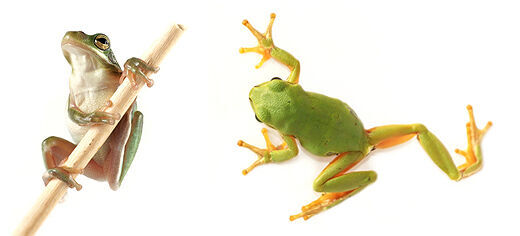
Researchers at the University of Leeds are using the feet of tree frogs as a model for a tiny robot designed to crawl inside patients' bodies during keyhole surgery.
The tiny device is one of a growing stable of bio-inspired robots being built in the University’s School of Mechanical Engineering and featured on the BBC’s The One Show last night.
It is designed to move across the internal abdominal wall of a patient, allowing surgeons to see what they are doing on a real-time video feed.
The tree frog’s feet provide a solution to the critical problem of getting the device to hold onto wet, slippery tissue when it is vertical or upside down. Although it is relatively easy to find ways of sticking to or gripping tissue, the patterns on the frog’s feet offer a way to hold and release a grip without harming the patient.
Lead researcher Professor Anne Neville, from the School of Mechanical Engineering at the University of Leeds, said: “Tree frogs have hexagonal patterned channels on their feet that when in contact with a wet surface build capillary bridges, and hence an adhesion force . It is the same kind of idea as a beer glass sticking to a beer mat, but the patterns build a large number of adhesion points that allow our robot to move around on a very slippery surface when it is upside down.”
Professor Neville said: “To work effectively, this robot will have to move to all areas of the abdominal wall, turn and stop under control, and stay stable enough to take good quality images for the surgeons to work with.
“While basic capillary action works to an extent, the adhesion fails as soon as there is movement, so we have looked at the tiny mechanisms used in nature. It is only if you look at the scale of a thousandth of a millimetre, that you can get enough adhesion to give the robust attachment we need.”
The frog-inspired robot has four feet – each capable of holding a maximum of about 15 grams for each square centimetre in contact with a slippery surface. The researchers are aiming for a device that is 20í—20í—20mm, though they have been working on a prototype that is near double this size.
They are now trying to halve the size of their prototype so that it can fit through the incisions made during keyhole surgery. The prototype’s weight is currently of the order of 20g and can be reduced much further.
The surgical device is one of a number of bio-inspired robots created by University of Leeds’ researchers featured on The One Show, including an electric ‘mole’ designed to dig through rubble in disaster zones and a giant robo-worm that mimics the nervous system of a real nematode worm.
Further information
Contact: Chris Bunting, Communications, University of Leeds. Tel +44 (0)113 343 2049 / 4031; email c.j.bunting@leeds.ac.uk / pressoffice@leeds.ac.uk.
The main work on the robot was carried out by two PhD researchers working on the adhesive pads – (Dr Greg Taylor and Ms Ashley Bell) - and another PhD researcher working on the design of the robot itself (Mr Alfonso Lopez). The team of academics in the School of Mechanical Engineering includes Drs Rob Richardson, Abbas Dehghani, Tomasz Liskiewicz and Ardian Morina and Professors Phil Gaskell and Martin Levesley. The clinical lead for the project is Professor David Jayne, Professor of Surgery at the University of Leeds and colorectal surgeon at Leeds NHS Teaching Hospitals Trust.
The study was funded by a £450,000 grant from the New and Emerging Applications of Technology (NEAT) fund.